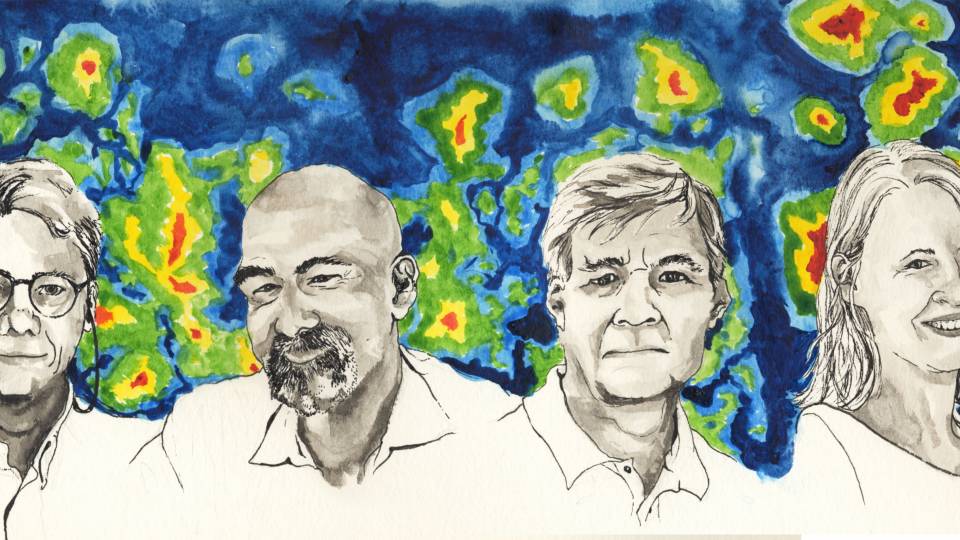David T. Wilkinson, a professor of physics whose research helped shape scientists' understanding of the structure of the universe and whose open and friendly manner made him a beloved colleague and teacher, died Thursday after a long bout with cancer. He was 67.
Wilkinson, Princeton's Cyrus Fogg Brackett Professor of Physics Emeritus, was a key figure in making the astronomical observations that, in the 1960s, gave a solid basis for the Big Bang theory of the universe. Over subsequent decades, he conceived and guided major satellite-based investigations that yielded further dramatic insights and continue to refine scientists' picture of the universe today.
"He was a mixture of a teacher and a scholar of a caliber that we were very lucky to have," said Joseph Taylor, dean of the faculty and longtime colleague in the physics department.
In addition to his research, he eagerly engaged in mentoring students, organizing innovative classes in physics, enlisting undergraduates in research and arranging stargazing gatherings. In his most recent project, he invited amateur astronomers and other volunteers to work side-by-side with Princeton scientists in a search for extraterrestrial intelligence.
"He was an inspiring figure as a physicist as well as a friend," said Jim Peebles, a theoretical cosmologist who worked closely with Wilkinson for 40 years. "He will be missed indeed."
Wilkinson joined the Princeton faculty in 1963 after earning B.S.E., M.S.E. and Ph.D. degrees from the University of Michigan. He began a search for a faint bath of energy that theorists had predicted would pervade space if the Big Bang theory were correct. The energy, called the cosmic microwave background, was postulated to be the afterglow of the initial fireball itself. The radiation was discovered in 1964 by researchers at Bell Labs who were awarded Nobel Prizes, but Wilkinson went on to confirm its existence and make increasingly subtle measurements that continue to shape cosmology.
"It really transformed the whole field of cosmology from a rather speculative and theoretical enterprise to one that has its basis in experimentally testable predictions and basic facts," Taylor said of the discovery and analysis of the cosmic microwave background.
Wilkinson's work in this area ushered in an era of cosmology that emphasized taking astronomical measurements with the kind of precision scientists expect of laboratory-based experiments, said physicist Lyman Page, a Princeton colleague. "The whole vision of doing really fundamental science from the cosmos grew out of his work," said Page.
One of the biggest advances in the field came in 1989 with the launch of a satellite called COBE, the conception and development of which was driven in large part by Wilkinson. The COBE satellite charted a sky-wide map of very slight variations in the radiation.
Peebles recalled the earliest days of planning for the COBE satellite and seeing Wilkinson on the telephone soliciting bids from aerospace companies that were needed to win a contract from NASA. "Here he is, a scientist who loves to get into the laboratory, sitting by the phone negotiating with contractors hour after hour. He had such focus and did it all so capably that COBE flew and was a spectacular success, just spectacular," said Peebles.
In 2001, NASA launched the MAP satellite, which is making an even more detailed map of the radiation. Although many scientists participated in its development, "Dave was really the father of MAP," said Page.
"He was the ideal of a scientist on absolutely every level," Page said. "He was an unparalleled statesmen for science, a promoter for the field and for good science everywhere, while at the same time never promoting himself." Wilkinson served on numerous high-level committees for planning and teaching initiatives for the National Academy of Sciences. He also chaired the Princeton physics department for three years and served on many University committees.
In 2001, the National Academy of Sciences awarded Wilkinson its James Craig Watson Medal for his contributions to the science of astronomy.
As influential as his own research, said colleagues, was the impact of Wilkinson's teaching and mentoring. "His former students really populate the field now," said Peebles. "Many, if not most of the people in experimental cosmology were at one time either his students or worked with him as postdoctoral fellows."
He also was an enthusiastic teacher of undergraduates, developing several new courses, including a sophomore course in experimental physics that he organized in the last couple of years before retiring earlier this year. In 1996, he received the Princeton President's Award for Distinguished Teaching.
"He left an outstanding legacy of teaching that was appreciated by the engineers and pre-med students who had to take physics and didn't think they would like it, but found it very exciting under his direction," said Taylor, who also noted that Wilkinson was the person who recruited him to Princeton in 1981.
"He was friendly and open and always had students stopping by," said Taylor. "If you wanted to talk physics, he was ready to chat with you."
A memorial service in Wilkinson's honor is being planned. Wilkinson is survived by his wife Eunice of Princeton, son Kent of San Antonio, Texas, daughter Wendy Gordon of Lambertville, N.J., stepchildren Marla Dowell of Boulder, Colo., Michael Dowell of Chicago and Janice Dowell of Bowling Green, Ohio, as well as five grandchildren.
In lieu of flowers, donations can be made to: ISLES ; or the Optical Search for Extraterrestrial Intelligence ( OSETI ) group in care of the Princeton University Department of Physics .
Contact: Marilyn Marks (609) 258-3601
